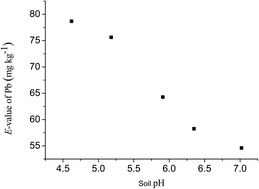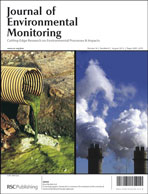Labile pools of Pb in vegetable-growing soils investigated by an isotope dilution method and its influence on soil pH
Abstract
Pollution of Pb in the surface of agricultural soils is of increasing concern due to its serious impact on the plant growth and the human health through the food chain. However, the mobility, activity and bioavailability of Pb rely mainly on its various chemical species in soils. In the present study, E and L values, the labile pools of isotopically exchangeable Pb, were estimated using the method of isotope dilution in three vegetable-growing soils. The experiments involved adding a stable enriched isotope (206Pb > 96%) to a soil suspension and to soils in which plants are subsequently grown, the labile pools of Pb were then estimated by measuring the isotopic composition of Pb in soil solutions and in the plant tissues, respectively. In addition, the correlation of E values and soil pH was investigated at the ranges of pH 4.5–7.0. The amount of labile Pb in soils was also estimated using different single chemical extractants and a modified BCR approach. The results showed that after spiking the enriched isotopes of 206Pb (>96%) for 24 hours an equilibration of isotopic exchanges in soil suspensions was achieved, and the isotope ratios of 208Pb/206Pb measured at that time was used for calculating the E24 h values. The labile pools of Pb by %E24 h values, ranging from 53.2% to 61.7% with an average 57%, were found to be significantly higher (p < 0.05) than the values estimated with L values, single chemical extractants and the ΣBCR values obtained with the BCR approach, respectively. A strong negative correlation (R2 = 0.984) between E24 h values and soil pH was found in the tested soil sample. The results indicate that the %E24 h value can more rapidly and easily predict the labile pools of Pb in soils compared with L values, but it might be readily overestimated because of the artificial soil acidity derived from the spiked isotopic tracer and the excess of spiked enriched isotopes. The results also suggest that the amounts of Pb extracted with EDTA and the ΣBCR values extracted with the modified BCR approach are helpful to detect the labile pools of Pb in soils. In addition, the negative correlation between soil pH and the labile pools of Pb in soils may be useful for further remediation to reduce the bioavailability of Pb in contaminated soils.


 Please wait while we load your content...
Please wait while we load your content...